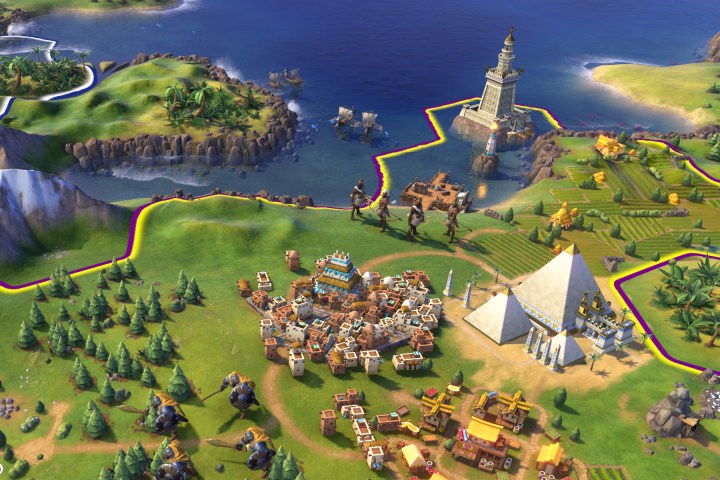
Through its stellar expansions and vibrant modding community, six-year-old Civ V is more playable now than ever, but it’s time to restart history with a clean slate. Enter Civilization VI, coming to PC on October 21, 2016.
We recently spoke with lead designer Ed Beach to get a first taste of how he and his team at Firaxis have been reinventing the wheel once again. Beach is no stranger to the series, having lead development on both of Civ V’s major expansions (Gods and Kings and Brave New World).
This land is your land
No longer crammed into a single tile, cities will now be able to luxuriate across the map with specialized districts. These will contain relevant buildings and boost the city in particular areas. For instance, a campus district for the library and university will increase a city’s science output. These bonuses can be enhanced even further through terrain adjacency bonus, such as placing a campus district next to mountains or rainforest for a scientific research boost, or an industrial district next to mines and quarries to increase production.
Wonders now also exist on the map, each taking up their own tile. Placement requirements for each wonder, such as the Pyramids needing a desert or Stonehenge needing a flat grassland, further complicate the puzzle of laying out each city.

These expansive cities will also transform the way warfare works in Civ VI. When cities were limited to a single tile, invading armies would simply swarm in, surround it, and pin it down with battering rams or artillery until its defenses gave way. Other tile improvements could be pillaged for a health boost, but that was a secondary concern. Now that a city’s functionality is spread out on the map, sieges become far more strategic, allowing for targeted strikes that can cripple cities without the need for outright conquest. For instance, if a civ seems to be getting dangerously close to a science victory, you can invade and take out their campus districts, crippling their research program. This also significantly complicates city defense.
Splitting the difference in combat
All of the changes detailed so far sound like smart evolutions of the game’s design.
Combat also continues to evolve more generally in Civ VI. The transition from IV’s “stacks of doom” and V’s one unit per tile created one of the Civ community’s largest rifts between players that preferred one mode over the other. VI aims to bridge that gap somewhat by introducing limited unit stacking. Two like units will be able to combine into a more powerful corps. There will also be a new class of support units that can be embedded in other units to supplement their power, such as assigning field medics or anti-tank artillery to a squad of infantry, or formally linking up warriors with vulnerable settlers for protection out in the wilderness.
The tactical concerns introduced in V with its hexagonal tiles and spread-out units will be enhanced by the map’s new relevance for cities. Limited stacking will also restore the relevance of unit composition that many players missed in V, leading to a generally more robust wargame.
Eureka!
Scientific progress in previous Civ games has been a relatively passive affair — players choose the next technology they want to research as they move up the tech tree, and their scientists passively chip away at it in the background while turns progress. This linear process led to somewhat static research orders that had little to do with whatever else was happening in the game. This led to strange situations like a civilization that hasn’t even encountered the ocean being equally capable of researching sailing as an island nation.

Now every tech on the tree has an associated activity in the rest of the game that will “boost” the research, providing a substantial boost to its progress even if the player hasn’t reached it on the tech tree yet. For instance, founding a coastal city or building ships will accelerate related nautical technologies. This creates feedback between research and the rest of the game as the tech tree unfolds itself in response to the player’s actions. Now it will be possible for the aforementioned landlocked civ to discover sailing without water, but it would take much longer to do so than a civ that actually engages with the sea.
What’s your agenda?
Every AI-controlled leader’s behavior is dictated by explicit agendas. One of these will be based on history and accessible to the player at the start of the game. The example that the designers provided was “to build a strong network of city-states” (which would presumably be the historical agenda of Greece’s Alexander the Great). The player would then know that cozying up to a lot of city-states will likely lead to conflict with them. In addition to their historical agendas, however, leaders will also have randomized hidden agendas that the player can learn about through sufficient contact, whether through diplomacy or espionage.
In practice, the agendas should help provide a little rhyme and reason to the AI leaders’ behavior. In Civ V they frequently behaved like petulant, irrational children — quick to anger, resistant to negotiation, and with very little transparency about why they would make a particular choice. The addition of agendas give them clear, systematized motivations that a player can consider and respond to accordingly.
And the kitchen sink
In previous iterations of the series, certain systems were left out of the initial release, which were then added in through subsequent expansions. Beach told us, however, that all of the major systems — including espionage, religion, tourism, archaeology, and trade routes — will be in place at launch. He admits that some will be more fleshed out than others, still leaving room for later additions, but the basics will be there. Beach cited his team’s experience on Civ V’s expansions as ideal preparation for tackling the core game’s entirety.

Multiplayer is also receiving an upgrade in VI, with an eye towards expediency. Even at the fastest speeds games can take more than five hours to complete. This is fine for solo play, but finding that much time with one or more friends can be a real pain, made even worse if playing hotseat and alternating turns on a single computer. To address this, the designers are adding multiplayer modes intended to be completed within a single session of a few hours. They have not yet offered any details of how these will work, but it’s an exciting prospect for players looking to get their multiplayer fix with limited schedules.
All of the changes detailed so far sound like smart evolutions of the game’s design. The actual layout of the map matters more, and spreading cities out will make them feel more specific and personalized. Change to combat may appease fans of both previous systems, and the addition of science boosts is an elegant way to tie the series-staple tech tree more directly into the rest of the game.
Stay tuned for more coverage of Civilization VI in the coming months before its October 21 release for PC.
Editors' Recommendations
- Civilization VI: All 42 leaders and cultures
- Civilization VI is this week’s Epic Games Store freebie


